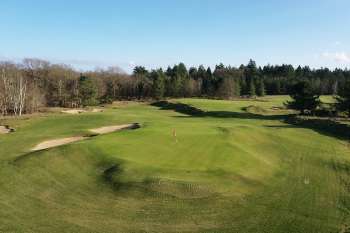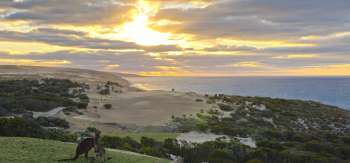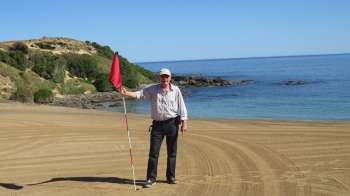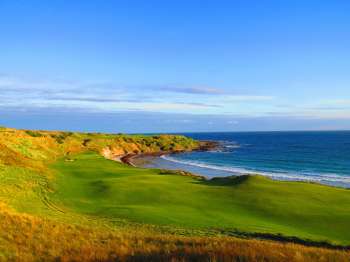New Course highlights Les Bordes approach to sustainability
Media Release:
NEW COURSE LAUNCH HIGHLIGHTS ENHANCED APPROACH TO SUSTAINABILITY AT LES BORDES
29 March: Set to be unveiled this summer, the New Course at Les Bordes is one of the golfing world’s most talked-about new design projects, and is at the heart of a comprehensive new eco-strategy devised by the luxury estate to deliver improved sustainability on and off the golf course.
The exclusive French venue is working in association with the Golf Environment Organisation (GEO) and following its ‘On Course’ environmental stewardship programme to implement a three-year plan that provides improved efficiency and a more sustainable performance across all areas of its estate.
As well as improving sustainability on its three courses – including the New Course, designed by acclaimed American architect Gil Hanse and due to open on July 1 – Les Bordes is adopting a more enhanced approach to conservation across its other sectors, including its array of sports and lifestyle facilities, general estate services and management of hundreds of acres of natural woodland habitat in the Sologne Forest.
Lee Strutt, golf superintendent and estate manager at Les Bordes, said: “The sustainable management of all three courses and the wider estate is at the forefront of our long-term approach to the environment.
“We started implementing ways in which our operation can be run more sustainably to improve efficiency in 2020 and this will continue as we work through the GEO programme. The New Course has been a main focus area for us to deliver better sustainability but there are many other environmental management practices that can be used across the wider estate, and we are aiming to introduce these over the next two years.”
A 90-minute drive south of Paris, Les Bordes Golf Club is a private members’ club and features 46 holes of golf – the 18-hole Old and New championship courses and the 10-hole Wild Piglet par-three course.
The first golf course to be designed by Hanse in continental Europe, the New Course fits harmoniously into its surroundings, with the fairways blending seamlessly into the natural vegetation and trees, and maximum care and attention was taken by Hanse and his team to clear the location and preserve the natural environment
With a hard-wearing fescue grass species used for all fine-turf areas of the par-72 layout, the course design has created low maintenance areas, meaning maintenance costs have been significantly reduced with less irrigation, fertiliser and pesticides required.
The New Course has been planted with 250,000 new heathers to expand the catchment area for wildlife that benefits from the extended heather swathes, while the majority of the course furniture has been made using recycled material from the estate or material that has been locally sourced.
In addition, a new maintenance and water-management programme has been implemented across the three courses to make fairways and greens firmer and faster, reducing irrigation levels and the electricity costs of the irrigation pumping station, while the promotion of healthier turf has helped Les Bordes to reduce the nutrient supplements needed by 40 per cent.
The far-reaching benefits of Les Bordes’ upgraded eco-strategy can also be seen away from the golf courses, with the estate management team planning a number of further improvements over the next two years to enhance the environment.
Among the measures being proposed is the development of a green-waste programme – using grass cuttings and leaves to generate composted material for use around the estate including in the horse paddocks and the landscaping of the venue’s new residential properties – and increased woodland management to improve the visual appearance and screening of areas.
A review of both birds and animals’ natural habitats on the 1,400-acre estate, identifying where numbers could be increased to enrich the environment, is also set to take place alongside a drive to improve Les Bordes’ approach to recycling, waste and packaging. In addition, within the GEO programme, there is a further incorporation of the clubhouse, hotel and service areas planned, including investigating the installation of light fittings that use less energy, with proximity sensors that automatically turn off light in rooms not used.
Strutt added: “These are early days for the estate in terms of improving our sustainable environment management but, with the changes that have been made on the golf courses, we have already made great progress.
“Everyone at Les Bordes has a long-term commitment to improving the estate by using sustainable practices that benefit the surroundings, are environmentally responsible and enhance the experience that we offer to our members and their guests.”
This July’s opening of Hanse’s New Course headlines three years of investment at Les Bordes, developing a community where all family members have endless possibilities for fun and adventure. Completed on-site amenities include natural swimming lakes and pools, beaches, watersports, go-karting, fishing, equestrian, petting farm and biking and walking trails.
Future investment plans include an announced partnership with Six Senses for the transformation of the 19th century ‘Chateau Bel Air’ into a luxury hotel and spa, a village square with shops and restaurants and a variety of residential villas in various styles, as well as an equestrian centre, an organic farm, an art gallery and outdoor amphitheatre.
Back to NewsMore News
The Cliffs Kangaroo Island Announces Preview Play in early 2026
Major milestone for stunning new destination course with preview play available from January 2026
Who Really Designed Cape Wickham Links?
AGD ranks Cape Wickham #1 in Australia & interviews Duncan Andrews to get full story on course design
Cape Wickham Links – The Inside Design Story
Co-designer Darius Oliver reveals the truth behind the design of Australia’s premier modern golf course
2025 Karrie Webb Series scholars announced
Two young golfers set to follow in the footsteps of some of Australia's best golfers after winning 2025 scholarships





